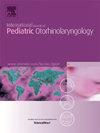The differential impact of bilingualism on stuttering severity, language-specific patterns, and therapy outcomes in children: A systematic review and meta-analysis
IF 1.2
4区 医学
Q3 OTORHINOLARYNGOLOGY
International journal of pediatric otorhinolaryngology
Pub Date : 2025-03-18
DOI:10.1016/j.ijporl.2025.112314
引用次数: 0
Abstract
Aims
This systematic review and meta-analysis aimed to evaluate (1) if bilingual children differ from monolingual peers in stuttering severity, (2) if severity varies between their first (L1) and second (L2) languages, and (3) how bilingualism affects treatment outcomes.
Methods
Twenty-six empirical studies were analyzed after a comprehensive search and screening. Random-effects models compared stuttering severity between bilingual and monolingual children, assessed L1 versus L2 differences, and evaluated fluency post-treatment.
Results
Bilingual children showed significantly greater stuttering severity than monolingual peers, likely due to heightened cognitive and speech motor demands of managing two languages. Severity was higher in L2 than L1, reflecting proficiency and dominance effects. Treatment outcomes revealed substantial fluency improvements in bilingual children, comparable to monolingual results. However, inconsistent bilingualism definitions and severity measures limited comparisons.
Conclusion
Bilingualism increases stuttering severity, particularly in L2, but does not impair treatment success. Comprehensive bilingual assessments and culturally responsive interventions are essential. Future research should use longitudinal designs, diverse language pairs, and standardized criteria to improve clinical practices for bilingual children who stutter.
双语对儿童口吃严重程度、语言特异性模式和治疗结果的不同影响:一项系统回顾和荟萃分析
本系统综述和荟萃分析旨在评估(1)双语儿童在口吃严重程度上是否与单语儿童不同,(2)母语和第二语言儿童的口吃严重程度是否存在差异,以及(3)双语如何影响治疗结果。方法对26项实证研究进行综合检索和筛选。随机效应模型比较了双语和单语儿童的口吃严重程度,评估了L1和L2的差异,并评估了治疗后的流利程度。结果双语儿童的口吃严重程度明显高于单语儿童,这可能是由于管理两种语言的认知和言语运动需求增加所致。第二语言的严重程度高于第一语言,反映了熟练程度和优势效应。治疗结果显示,双语儿童的流利程度有了实质性的改善,与单语儿童的结果相当。然而,不一致的双语定义和严重程度测量限制了比较。结论双语会增加口吃的严重程度,尤其是第二语言,但不会影响治疗的成功。全面的双语评估和符合文化的干预措施至关重要。未来的研究应采用纵向设计、多样化的语言对和标准化的标准来改善双语儿童口吃的临床实践。
本文章由计算机程序翻译,如有差异,请以英文原文为准。
求助全文
约1分钟内获得全文
求助全文
来源期刊
CiteScore
3.20
自引率
6.70%
发文量
276
审稿时长
62 days
期刊介绍:
The purpose of the International Journal of Pediatric Otorhinolaryngology is to concentrate and disseminate information concerning prevention, cure and care of otorhinolaryngological disorders in infants and children due to developmental, degenerative, infectious, neoplastic, traumatic, social, psychiatric and economic causes. The Journal provides a medium for clinical and basic contributions in all of the areas of pediatric otorhinolaryngology. This includes medical and surgical otology, bronchoesophagology, laryngology, rhinology, diseases of the head and neck, and disorders of communication, including voice, speech and language disorders.

 求助内容:
求助内容: 应助结果提醒方式:
应助结果提醒方式:


